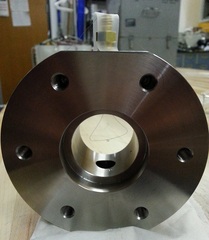Marc Baumgardner, PhD
Dual Fuel Combustion
Anthony
J. Marchese (Colorado State University) and Marc E. Baumgardner (Gonzaga University)
--------------
Overview.
The
combustion of two fuels with disparate reactivity (i.e. dual fuel) in an
internal combustion engine has been demonstrated as a means to increase fuel
efficiency, reduce fuel costs and reduce pollutant formation in comparison to
traditional diesel or spark ignited engines.
There is currently a major economic incentive to utilize natural gas in
dual fuel applications and to maximize the substitution percentage of natural
gas because of the historically low cost of natural gas per unit of energy
relative to diesel fuel. However, since natural gas substitution schemes often
utilize high compression ratio engines, the natural gas substitution percentage
is limited by uncontrolled fast combustion or engine knock. To increase the
natural gas substitution percentage, a greater understanding of the processes
that lead to uncontrolled combustion rates in dual fuel engines is needed.
Droplet ignition/combustion in a premixed fuel-air ambient under engine-like
conditions (e.g. rapidly increasing temperature and pressure) represents an
ideal environment to study dual fuel ignition phenomena because its geometric
simplicity enables computations with full detailed chemistry with direct
comparisons against optical diagnostics. Accordingly, the development of a
system allowing the study of ignition and combustion of a liquid droplet in a
lean premixed fuel-air environment in a rapid compression machine (RCM)
represents a critical next step in exploring dual fuel combustion.
Intellectual Merit. Droplet evaporation and combustion has been studied for over 60 years and has proven to be an invaluable tool with which to examine a wide array of combustion applications. To date the bulk of research has consisted of examining droplets in O2/inert environments at near ambient temperatures and pressures. Studies conducted at elevated temperatures and pressures typically vary only one of these two parameters, and true engine-like conditions have only just begun to be examined. Additionally, true dual fuel combustion wherein the ambient is a lean mixture of fuel-air has not been substantially studied. The primary objectives of this study will be to demonstrate the ability to hold a droplet in fixed position under a lean ambient fuel-oxidizer environment subject to rapid temperature and pressure increases leading to evaporation and subsequent combustion and to optically examine said droplet throughout the entire process. Initially, due to the present interest in diesel-natural gas dual fuel engines, n-heptane fuel droplets will be combusted in lean methane/air environments. A secondary goal will be to develop an accurate chemical-kinetic mechanism capable of capturing the complex effects of diesel-natural gas dual fuel combustion for use in computational engine modeling. It is expected that the outcomes of this work will have substantial impact for enabling dual fuel combustion in current internal combustion engines and also many types of future combustion strategies.
To achieve these
goals, the following specific tasks will be accomplished:
- Demonstrate
the ability to ignite a stationary droplet in a stagnant flow field under rapidly
increasing temperature and pressure in an RCM
- Examine
optically the entire process of RCM compression leading to droplet evaporation,
ignition of the premixed fuel/air vapor in the vicinity of the liquid droplet,
ignition of the premixed natural gas/air mixture, propagation of a premixed
natural gas/air flame away from the liquid droplet and non-premixed combustion
of the liquid droplet.
- Quantify
relevant combustion phenomena such as ignition conditions, ignition delays,
flame spread rates, and minimum flammability limits of the lean ambient mixture
as they relate to droplet ignition
- Develop
a droplet ignition code capable of incorporating the relevant physics with
sufficiently large chemical-kinetic mechanism so as to accurately describe the
observed combustion
- Create an accurate reduced chemical mechanism capable of describing the initial dual fuel case of n-heptane droplets in lean methane/air environments



